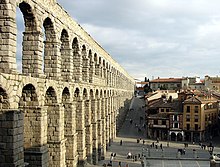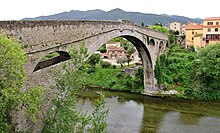Arch bridge
[5] A more complete survey by the Italian scholar Vittorio Galliazzo found 931 Roman bridges, mostly of stone, in as many as 26 countries (including former Yugoslavia).[8] Generally, Roman bridges featured wedge-shaped primary arch stones (voussoirs) of the same in size and shape.Trajan's bridge over the Danube featured open-spandrel segmental arches made of wood (standing on 40 m-high (130 ft) concrete piers).Gothic pointed arches were also introduced, reducing lateral thrust, and spans increased as with the eccentric Puente del Diablo (1282).[11] Constructions such as the acclaimed Florentine segmental arch bridge Ponte Vecchio (1345) combined sound engineering (span-to-rise ratio of over 5.3 to 1) with aesthetical appeal.Such low rising structures required massive abutments, which at the Venetian Rialto bridge and the Fleischbrücke in Nuremberg (span-to-rise ratio 6.4:1) were founded on thousands of wooden piles, partly rammed obliquely into the grounds to counteract more effectively the lateral thrust.In more modern times, stone and brick arches continued to be built by many civil engineers, including Thomas Telford, Isambard Kingdom Brunel and John Rennie.A key pioneer was Jean-Rodolphe Perronet, who used much narrower piers, revised calculation methods and exceptionally low span-to-rise ratios.Roman civil engineers developed the design and constructed highly refined structures using only simple materials, equipment, and mathematics.This type is still used in canal viaducts and roadways as it has a pleasing shape, particularly when spanning water, as the reflections of the arches form a visual impression of circles or ellipses.The central part of the deck is supported by the arch via suspension cables or tie bars, as with a tied-arch bridge.The tie is usually the deck and is capable of withstanding the horizontal thrust forces which would normally be exerted on the abutments of an arch bridge.This type of bridge is suitable where a temporary centring may be erected to support the forms, reinforcing steel, and uncured concrete.











Arch Bridge (disambiguation)A double-arch stone bridgeNagasakiClapper bridgeTruss arch bridgemoon bridgePedestriansvehicleslight railheavy railmasonryconcretewrought ironcast irontimberstructural steelFalseworkabutmentsviaductList of Roman bridgesList of medieval stone bridges in GermanyList of medieval bridges in FranceAlcántara BridgeAnji BridgeMycenaeanArkadiko Bridgecorbel archHellenisticEleutherna BridgeRhodes Footbridgevoussoirtrue archesEtruscansancient GreeksRomansRoman bridgesYugoslaviasemicircularAlconétar BridgesegmentalvoussoirsaqueductsPont du GardSegovia AqueductPons FabriciusIndustrial RevolutionOpus caementiciumashlarLimyra BridgeTurkeyTrajan's bridgeDanubespandrelPuente RomanoMéridaKaramagara BridgeCappadociaDevil's bridgeCéretmedievalGothicPuente del DiabloPuente de San MartínCastelvecchio BridgePont Grandbridge at Trezzo sull'AddaPonte VecchioFlorenceFlorentineRenaissancePonte Santa TrinitaVenetianRialto bridgeFleischbrückeNurembergRichmond BridgeZhaozhou BridgeBridge of ArtaCenarth BridgeThe Iron BridgeThomas TelfordIsambard Kingdom BrunelJohn RennieJean-Rodolphe PerronetcenteringMonroe Street BridgeSpokane, WashingtonKerava RiverKeravaFinlandcompressiontensioncentringkeystonesettlementfoundationsBridge at Limyrarunning bondparapetCyclopean masonryisosceles triangletrue archPont-Saint-Martinaqueductcivil engineersGrosvenor Bridge (Chester)Alexander Hamilton BridgeGalena Creek Bridgecathedral arch bridgeTimeline of three longest supported deck arch bridge spansThrough arch bridgeCotter Bridgetied-arch bridgeSydney Harbour BridgeBayonne BridgecatenaryFremont Bridgethrough the archties the archHinged arch bridgecrown of the archStari mostMostarBosnia and HerzegovinaAlte NahebrückeKrämerbrücke